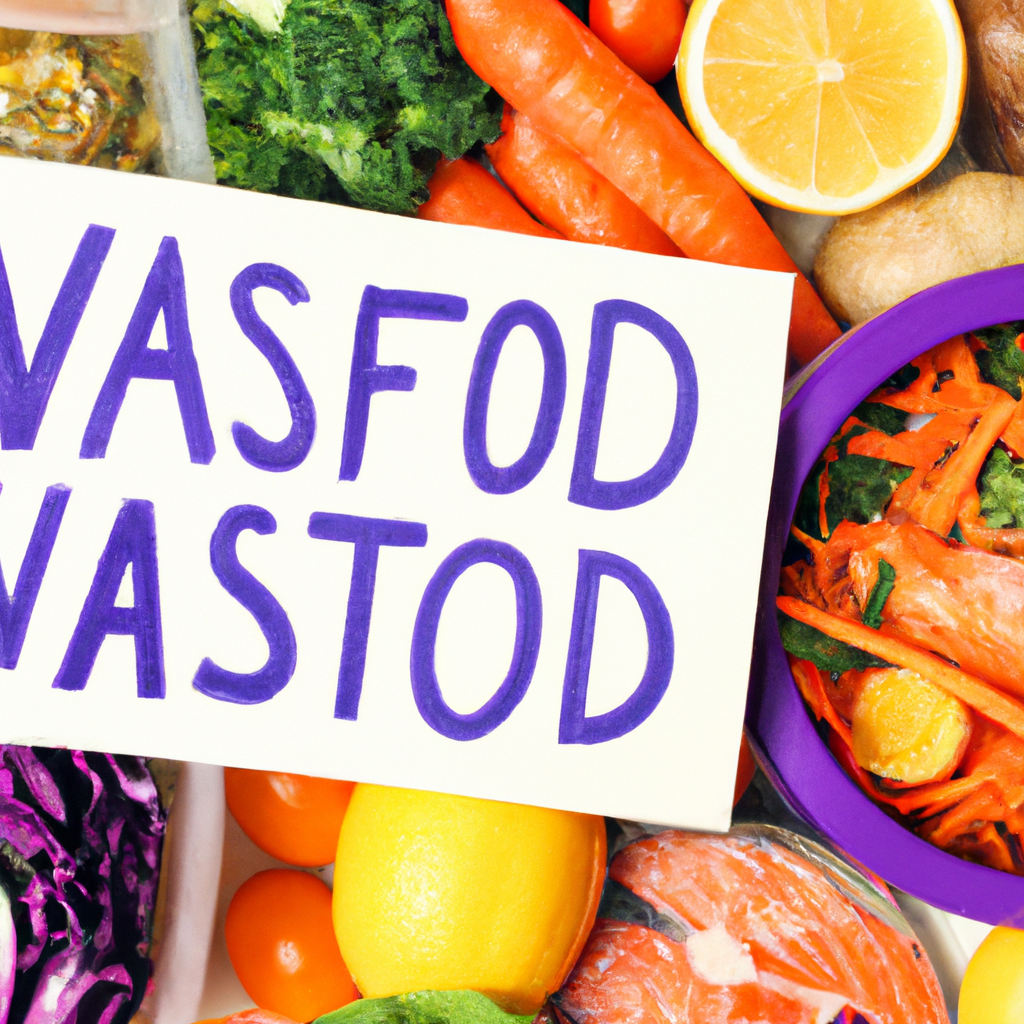In a world where food is plentiful, it’s easy to overlook one glaring issue that plagues our societies: food waste. Mountains of perfectly good food end up in the trash, leading to not only a colossal waste of resources but also exacerbating global hunger woes. But fear not, dear reader, for mankind has an opportunity to rewrite this tragic tale. Welcome to a world where smart storage and mouth-watering recipes come together in perfect harmony, paving the way towards reducing food waste. In this article, we embark on a flavorful journey, exploring inventive storage solutions and tantalizing recipes that not only satiate our taste buds but also inspire a more sustainable way of life. Prepare yourself to discover the secrets behind preserving ingredients at their peak, while unleashing the extraordinary potential of leftovers. Grab your apron and let’s dive into the world of reducing food waste – a realm where flavor reigns supreme and sustainability becomes our guiding light.
1. From Wasted to Savored: Revolutionizing Food Storage to Minimize Waste
In today’s fast-paced world, food waste has become a pressing issue that demands our attention. Every year, billions of tons of food end up in landfills, contributing to environmental degradation and exacerbating global hunger. However, in the midst of this wastefulness, a revolution is quietly taking place in the realm of food storage.
Gone are the days of traditional plastic containers and flimsy zip-lock bags. Innovators around the world have been tirelessly working to develop game-changing solutions that not only prolong the shelf life of food but also transform leftovers into delectable meals. These groundbreaking storage methods are reshaping our relationship with food, enabling us to savor every last morsel instead of letting it go to waste.
One remarkable development that has taken the culinary world by storm is vacuum sealing. By removing air from storage containers, this method effectively keeps food fresh for longer periods, minimizing spoilage. Imagine opening a container filled with vibrant vegetables, just as crisp and flavorful as they were when you first bought them. With vacuum sealing, that dream becomes a reality.
Another exciting innovation in food storage is the rise of sustainable packaging alternatives. From biodegradable wraps made from plant-based materials to reusable beeswax wraps that can be washed and used again, the market is teeming with environmentally-friendly options. These alternatives not only reduce plastic waste but also lock in freshness and flavor, ensuring that your food stays at its peak for as long as possible.
Furthermore, repurposing leftovers has never been easier with the advent of creative storage solutions. With stackable and compartmentalized containers, you can effortlessly transform yesterday’s dinner into today’s gourmet lunch. By organizing and storing various components separately, these containers keep flavors intact, preventing your meals from tasting like a mere mishmash of mixed ingredients.
Beyond physical storage, technology has also played a significant role in minimizing food waste. Smart refrigerators equipped with advanced sensors can monitor the freshness of perishable goods, sending alerts when items are about to expire. This not only prevents food from going bad but also encourages mindful consumption, as users can plan meals around the ingredients that need to be used before they spoil.
2. Unlock the Secrets of Smart Storage: Preserve Food, Preserve the Planet
Are you tired of throwing away perfectly good food because it spoils too quickly? Look no further! In this section, we will delve into the secrets of smart storage that will not only help you preserve your precious groceries but also contribute to a greener planet.
One of the keys to smart storage is knowing which foods are best kept in the refrigerator and which ones should be stored at room temperature. For example, fruits like bananas, apples, and oranges should be kept outside the fridge to maintain their flavor and texture. On the other hand, vegetables like lettuce, carrots, and cucumbers benefit from being stored in the cold to stay crisp and fresh. By understanding these storage preferences, you can prolong the shelf life of your fruits and vegetables, reducing waste and saving money.
Another secret to smart storage is utilizing proper containers. Invest in airtight containers or resealable bags to prevent air and moisture from entering, creating an environment where bacteria can thrive. These containers are perfect for storing leftovers and pre-prepared meals. Additionally, consider using glass containers instead of plastic, as they are more durable and can be easily reheated or placed in the freezer.
Don’t underestimate the power of organizing your fridge! Creating a system where similar items are grouped together not only saves you time and effort but also minimizes food waste. Designate specific areas for dairy products, meats, vegetables, and condiments to make it easier to find what you need without rummaging through the fridge. Labeling your containers with the date of storage can also help you keep track of freshness and ensure that you use older items before they spoil.
Lastly, let’s not forget about the ultimate secret to smart storage: understanding expiration dates. While these dates serve as a general guideline, they are not set in stone. Many foods are completely safe to consume even after their expiration date has passed. Utilize your senses – if the food looks, smells, and tastes fine, it’s most likely still good to eat. By relying on your judgment instead of blindly following expiration dates, you can further reduce waste and make the most of your groceries.
3. Waste Not, Want Not: Innovative Recipes to Transform Leftovers into Culinary Delights
Do you often find yourself with a fridge full of leftovers wondering what to do with them? Look no further! We have compiled a list of creative and delicious recipes that will help you turn those forgotten scraps into impressive culinary creations.
1. Leftover Pizza Frittata
Transform yesterday’s pizza into a mouthwatering breakfast or brunch dish. The key is to chop the leftover pizza into bite-sized pieces and mix it with whisked eggs. Cook it on the stove with some olive oil until it’s golden and crispy. Serve it with a side salad and enjoy the fusion of flavors.
2. Veggie Stir-Fry Fried Rice
Leftover rice can be a lifesaver when you’re short on time. Take those plain grains and turn them into a flavorsome veggie stir-fry fried rice. Sauté your favorite vegetables, such as bell peppers, carrots, and baby corn, in a wok with some soy sauce and garlic. Add the cold rice and stir-fry everything until it’s heated through. Top it off with a sprinkle of spring onions for an extra kick.
3. Chicken Pot Pie Soup
If you have leftover roasted chicken and some vegetables, it’s time to make a hearty pot pie soup. Sauté onions, carrots, and celery in a pot until they soften. Add chicken broth, diced chicken, and any other leftover veggies you have. Let it simmer until the flavors meld together. Serve it with a crusty bread roll, and you have a comforting meal that will warm your soul.
These are just a taste of the endless possibilities you have with leftovers. Remember, the key is to be creative and experiment with what you have. Embrace the challenge of turning forgotten ingredients into culinary delights, and you’ll never waste a leftover again!
4. Creating a Sustainable Kitchen: Elevating Food Storage and Cooking to Fight Against Food Waste
When it comes to creating a sustainable kitchen, every small change we make can have a big impact on reducing food waste. By optimizing our food storage and cooking practices, we can play a vital role in preserving our planet’s resources. So, let’s dive into some creative ways to elevate your kitchen and join the fight against food waste.
1. Mindful Meal Planning: Start by taking a moment to plan your meals and make a shopping list before heading to the grocery store. This not only helps you to only buy what you need but also prevents impulse purchases that often lead to food waste. By organizing your meals ahead of time, you’ll be able to use up ingredients efficiently and avoid unnecessary spoilage.
2. Smart Storage Solutions: Introducing proper food storage techniques can significantly extend the shelf life of perishables. Invest in airtight containers, reusable silicone bags, and glass jars to keep your fruits, vegetables, and leftovers fresh for longer. Label and organize your pantry and fridge to avoid forgetting about hidden items that may end up being wasted.
3. Repurposing Leftovers: Get creative with your leftovers instead of tossing them in the bin. Transform yesterday’s dinner into a delicious lunch by incorporating ingredients into new recipes or simply reheating them with a twist. This not only saves food from going to waste but also introduces exciting flavors to your meals.
4. Composting Made Easy: Composting is a fantastic way to reduce food waste and create nutrient-rich soil for your garden. Set up a compost bin in your kitchen or consider joining a local composting program. You’ll be amazed at how much organic waste can be turned into valuable compost, enriching both your plants and the environment.
5. Supporting Local Food Banks: Sometimes, despite our best efforts, we end up with excess food that we won’t be able to consume. Instead of letting it go to waste, consider donating it to local food banks or community organizations that work towards alleviating hunger. One person’s surplus can make a significant difference in someone’s life.
Elevating your kitchen to become more sustainable is not only an extension of your commitment to the environment but also a way to contribute to the global fight against food waste. By incorporating these creative strategies into your daily routines, you’ll be making a tangible difference and inspiring others to join the cause. Let’s all work together towards a future with less waste and more delicious meals!
With the right knowledge, smart storage, and creative recipes, reducing food waste need not feel daunting. Every bit of effort helps to ensure that edible food is making its way to those who need it, while also protecting our planet. Let’s all take these steps to reduce food waste today – our stomachs, wallets, and environment will thank us.


